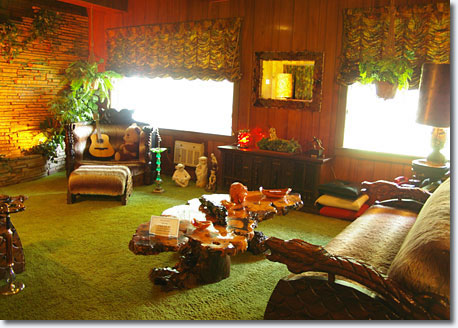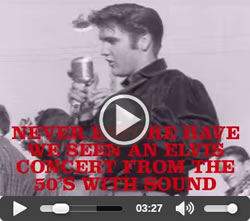Elvis Presley's Graceland | 3764 Elvis Presley Boulevard
The unique association between Elvis Presley and Graceland, his home in Memphis, Tennessee, for more than 20 years (1957-1977), is so powerful that Elvis and Graceland are essentially interchangeable.
When Elvis Presley was a young boy, he promised his parents he would make a lot of money and buy them the finest house in town, putting an end to years of struggle. For Elvis Presley, Graceland - a charming and stately colonial revival-style mansion for himself and his parents - was the fulfillment of that childhood promise.
Elvis' outstanding career spanned more than 20 years, crossed three pivotal decades, and encompassed three separate phases, but they were all variations on a lifelong theme of music. Early on, Elvis became known around the world by his first name alone, a universal recognition that still prevails in the twenty-first century.
1034 Audubon Drive
The Presleys bought their first house in 1956, a modest three-bedroom ranch-style house on Audubon Drive in east Memphis, but it did not meet their needs for very long.
3764 Highway 51 South : Graceland
On March 17, 1957, they purchased Graceland for US$102,500 and it was where Elvis lived for the next 20 years. After his death on August 16, 1977, Graceland was valued at US$350,000. Because of an annual upkeep bill estimated at US$500,000, the mansion was opened to tourists by Priscilla Presley on June 7, 1982.
![]() View a tour of Graceland (22:35) Experience 'visiting Graceland'.
View a tour of Graceland (22:35) Experience 'visiting Graceland'.

Elvis Presley's Graceland - 3764 Elvis Presley Boulevard.
We're Gonna' Move

Elvis buys $100,000 home. |
Gladys was approached by realtor Virginia Grant who was aware the Presley's were looking to move. And it was a fairly straight forward search for someone that within a space of one year did not need to be concerned about money (To the surprise of realtor Virginia Gran who initially underestimated their buying power) when buying what would have to have been Memphis' and perhaps (one of?) Tennessee's most highly priced properties. the Presley's managed to impress the owners in more ways than one to gain the status of favourite buyer.
1956
For Elvis Presley, 1956 was a year like no other. In January, he was a regional sensation, but by year's end he had become a national and international phenomenon. He made his first two albums for RCA (both million sellers), appeared on national television 11 times, signed a seven-year contract with Paramount Pictures, and stared in his first movie, 'Love Me Tender'. Elvis' appearances on national television were pivotal events for America because his unconventional appearance and performing style caused nationwide controversy. Presley outraged adults, mesmerized the teenagers of the new youth generation, and soon became the leader of the cultural revolution sweeping across the country.
 Video : Home Movies of Elvis at Graceland
Video : Home Movies of Elvis at Graceland
Elvis Buys Graceland | March 17, 1957
 |
| Peacock stained glass inside the living room of Graceland : 1970s. |
The house and farm that became Elvis Presley's Graceland predated his purchase and residence by almost two decades. The Graceland property was originally established as a 500 acre farm during the American Civil War (1861-1865) by publisher Stephen C. Toof (Owner of the Memphis Daily Appeal).
Ruth Brown Moore, the granddaughter of Stephen C. Toof, inherited Toof's farm from his daughter, her aunt Grace. In 1939, Mrs. Ruth Brown Moore and her husband, Dr. Thomas D. Moore, built a two-story Classical Revival residence and outbuildings on the land that had been in her family for almost 100 years and named it and the cattle farm they have as Graceland Farms in honor of her Aunt Grace. The architects were Max Furbringer and Merrill Ehrman. The builder was Robert Crouch.
The Moore's had a daughter, Ruth Marie, a musical prodigy who played the piano and the harp at age four.
A prominent Memphis architectural firm, Furbringer and Erhman, designed the house to showcase Ruth Marie's talent, designing the large rooms across the front of the house so they 'could be opened up to seat five hundred people for a musical event'.
Elvis purchased the property from Ruth Marie in 1957, herself to later become a celebrated harpist with the Memphis Symphony. So Ruth Marie sold to another talented musician in Elvis Aaron Presley.
On Saturday, March 17, 1957, Elvis' mother and father called real estate agent Virginia Grant to see what she had to offer.
Grant wasted no time. That day she showed them two properties, leaving Graceland to last. By 6 p.m. she had accepted a $1,000 deposit from the Presley's and drawn up a provisional sales contract detailing the terms of sale, including an asking price of $90,000.
At 10:00 a.m. on Monday, March 19, 22-year-old Elvis, accompanied by his parents, met Grant at Graceland. At this time the property was a 13.8-acre 'farm' about 10 miles south of downtown Memphis in Whitehaven, an area that was still largely rural at that time.
The property included a large, two-story house, a barn, and rolling pastures. Elvis surveyed the property for a few minutes, then baptized the house by playing some Rock 'N' Roll at a piano. Elvis, Vernon and Gladys Presley signed the sales contract on the spot as purchasers, and a closing date was set for Tuesday, March 26, at 4:30 p.m.
Elvis was fortunate to get Graceland as it had already been sold to the YMCA for US$35,000 when he saw it. By upping the price significantly Elvis finally obtained his 'home'. The purchase was funded by a combination of $10,000 cash deposit, trade of the Presley home on Audubon Drive for $55,000 and mortgage of $37,500.
When Elvis was a poor youngster, he frequently told his parents that some day he would make a lot of money, buy them the finest house in town, and end their years of hard work and financial struggle.
Moving In
In April 1957, the Presleys moved in - Elvis, his parents, and his grandmother, Minnie May Presley.
Easter 1957
![]() Elvis Presley with Yvonne Lime | Easter 1957
Elvis Presley with Yvonne Lime | Easter 1957
The Music Gates
When Elvis Presley purchased Graceland, the music gates were not a part of the property. Designed for Elvis by Abe Saucer and custom-built by John Dillars, Jr., of Memphis Doors, Inc., the custom music gates were delivered and installed on April 22, 1957.
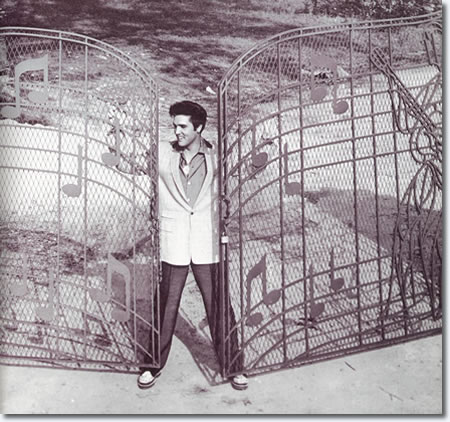
Elvis at the Graceland Gates 1957.

The Graceland Musical Gates.
Christmas 1957
Christmas, or to be more precise, bought both good and bad, the good, spending the first Christmas with his mom and dad at Graceland, but also on Friday December 20, Elvis received his draft notice. 'It's a duty I've got to fill and I'm going to do it', he said. Initially ordered to report for duty January 20, he received a deferment for the filming of 'King Creole' (at that time titled 'Sing, You, Sinners') which was already in pre-production.
 Elvis Presley's Graceland Tour
Elvis Presley's Graceland Tour
In this video you can see a little of the once in a lifetime experience that is visiting Graceland. You will then want to visit Graceland we are sure. As you step inside Graceland Mansion, you will follow in the same steps as Elvis himself and see where Elvis lived, relaxed and spent time with his friends and family. Graceland tours offer a very personal look inside the home of the King of Rock 'n' Roll.
The deferment was granted and Elvis was inducted March 24, 1958.
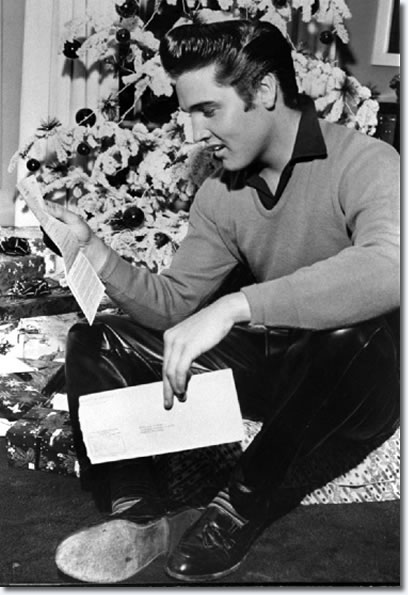
December 20, 1957 Elvis received his draft notice.
December 25, Elvis spends Christmas at Graceland ![]() with his parents.
with his parents.
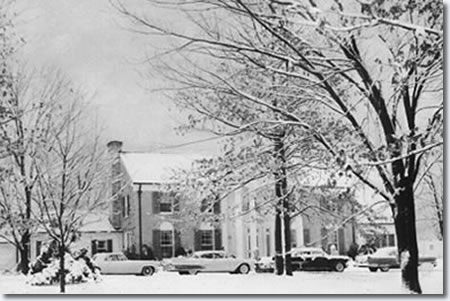
Graceland Christmas 1957.
 Drone Footage of Graceland
Drone Footage of Graceland
Working On The Building
Elvis added buildings, structures, and other additions to the property after his purchase in March 1957, and there has been some limited construction to accommodate visitors since the site opened to the public in 1982. Renovations over the years have seen Graceland grow from 10,266 square feet to 17,552 square feet. While Elvis liked redecorating, his parents added their own touches: a vegetable garden and a chicken coop.
3764 Elvis Presley Boulevard
When Elvis purchased Graceland in 1957, Highway 51 South and the area known as Whitehaven were 'out in the country'. By the 1970s, shopping centers, housing developments and apartment complexes had sprung up in the area only 12 miles south of downtown Memphis.
The City Council of Memphis, Tennessee voted to officially change the name of Highway 51 South to Elvis Presley Boulevard on June 29, 1971. The first sign was erected in January 1972 at a ceremony outside Graceland with Memphis Mayor Wyeth Chandler and Elvis' father Vernon Presley.
The actual street address of Graceland became 3764 Elvis Presley Boulevard.
Graceland = Home
Elvis and his parents called Graceland home for the remainder of their lifetimes. Also resident at Graceland was Elvis' maternal grandmother, Minnie Mae Presley, who outlived her son, daughter-in-law and grandson, passing away on May 8, 1980 at the age of 86. Vernon's sister, Delta, also lived at Graceland for a number of years.
The Meditation Garden
The Meditation Garden, just south of the swimming pool area, was constructed 1964-1965. It was built by Elvis as a place for contemplation. It includes a circular pool containing circular fountain jets, and a semi-circular pergola of Ionic columns on the south side of the pool with fountains. A stepped brick wall with four arched openings containing stained-glass panels curves to follow the pergola and encloses the Meditation Garden's south end. Presley planned this garden as a private retreat.

The Meditation Gardens.
The Garden's centerpiece is a circular twelve-foot fountain pool with five single jets of water and a larger one in the middle all lit by colored floodlights. It includes a circular pool containing circular fountain jets, and a semi-circular pergola of Ionic columns on the south side of the pool with fountains.
A stepped brick wall (Made of Mexican brick) with four arched openings containing stained-glass panels curved to follow the pergola and encloses the Meditation Garden's south end.
After Elvis' death on August 16, 1977, security issues at Forest Hill Cemetery, his original burial site, led to his reburial on October 2, 1977 on the south side of the pool with fountains. An eternal flame encased in a hexagonal glass container sits at the head of Elvis' grave. Elvis' mother Gladys was also reburied in the Meditation Garden, and the large marble monument from the Presley family plot at Forest Hill was relocated as well. Elvis' father Vernon was buried here in 1979, and his grandmother Minnie May Presley followed in 1980. The Meditation Garden also features a marker in memory of Elvis' still-born twin brother, Jesse Garon.
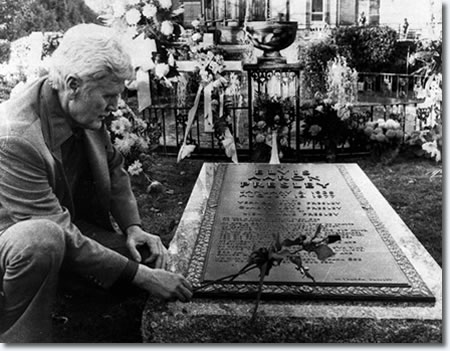
Vernon Presley at Elvis' grave at Graceland, 1977.
Present and Historic Physical Appearance
Graceland is about ten miles south of downtown Memphis, Tennessee, on Elvis Presley Boulevard (Highway 51 South - 3764 Elvis Presley Boulevard). The property includes a large house with later additions, a number of outbuildings, ancillary structures, and landscape features.
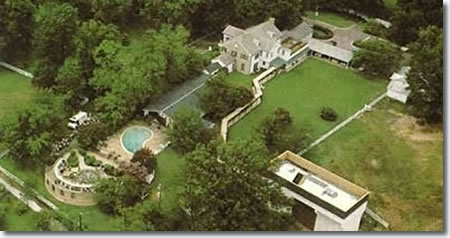
Elvis Presley's Graceland.
Elvis added buildings, structures, and other additions to the property after his purchase in March 1957, and there has been some limited construction to accommodate visitors since the site opened to the public in 1982.
The house was constructed at the top of a hill, almost at the center of the property in a grove of oaks, with rolling pastures in front and behind it, and a western exposure towards the Mississippi River. A curving driveway, bordered by a six-inch concrete curb lined with small electric lights along the outside edge, approaches from the state highway at the foot of the hill and form a large loop that passes in front of the house and returns back down the hill. A wall constructed of pink Alabama fieldstone bounds the highway frontage on the west side, and runs along the side property lines almost to the site of the residence at the top of the hill. A tall, wooden fence abuts the ends of the stone wall and surrounds the remainder of the grounds.
The entrance to the property at the northwest corner has brick walls on both sides of the driveway, and a pair of large, curved, wrought iron gates (Built in 1957), decorated with guitar players and musical notes, that form an open music book when closed. There is a small brick guard house (Built in 1971) just inside the large gates on the right side of the entrance, and a shuttle bus stop (1982) near the top of the driveway.
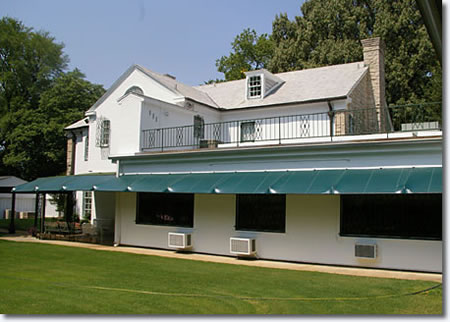
Graceland, much smaller than most people expect, as seen from the rear.
The house is a two-story, five bay residence in the Classical Revival style with a side-facing gabled roof covered in asphalt shingles, a central two-story projecting pedimented portico, and one-story wings on its north and south sides. There are two chimneys; one on the north exterior side wall, and a second chimney that rises through the roof ridge on the south side of house. The front and side facades of the central block are veneered with Tishomingo limestone from Mississippi, and its rear wall is stuccoed, as are the one-story wings. Front facade fenestration at the first floor includes 12-over-12 double-hung windows set in arched openings with wooden panels above the windows, and six-over-six double-hung windows at the second floor. Four stone steps ascend from the driveway to the two-story central projecting portico. Its pediment has dentils, a central, small, leaded oval window, and rests on a full entablature supported by pairs of columns with Tower of the Winds capitals. The columns at the corners of the portico are matched by pilasters on the front facade.
The doorway has a broken arched pediment, full entablature (including triglyphs and metopes), and engaged columns. Its transom and sidelights contain elaborate, colorful stained glass, a 1974 addition. Above the main entrance is a window with a shallow iron balcony.
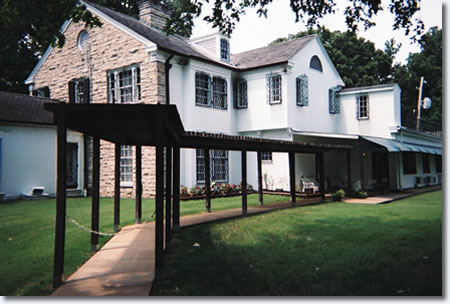
Graceland, the walkway at the rear of the house.
The one-story wing on the north end of the main block of the house is stuccoed and has two six over-six windows on its front (west) facade. Attached to this wing is an additional one-story stuccoed wing that originally housed a four-car garage. This section was remodeled as an apartment in the mid-1960s. The one-story wing on the south end is also stuccoed with a large four-part, multi-paned window at the center of the front (west) facade, and two multi-paned glass doors on the east facade. Photos of Graceland 1962.
The Music Room
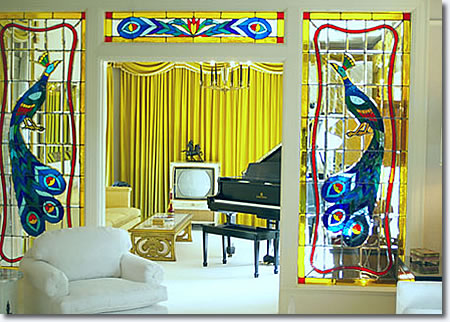
The Music Room at Graceland.
Living and Dining Rooms
The floor plan of the original building was basically in the shape of a cross, although the horizontal cross element is longer and wider than the vertical element of the plan. The entrance door opens into a wide and long central hall with a stair that rises to the second floor at the back, left (north) end of the hall. There are tall, wide, elliptical-arched openings from the center hall into the living room on its right (south) side and the dining room on its left (north) side. The arches are ornamented with keystones and paneled reveals, and carried on fluted pilasters. The width of these arched openings creates an open horizontal space across the front of the house. The hall, living room, and dining room have classical moldings.
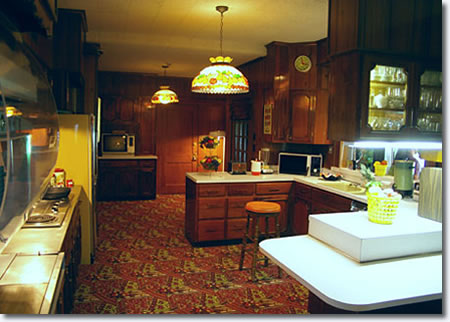
The Graceland Kitchen.
Custom mirrors were also added to the entire east wall of the living room in 1974, including the fireplace on this wall. There is a large, rectangular opening between the living room and the music room in the one-story wing to the south. Its transom and sidelights contain custom-made stained glass by Laukuf Stained Glass of Memphis, another 1974 addition. The large sidelights feature matching blue peacocks.
The dining room has rounded curio cabinets in both corners at the north end of the room, and black marble flooring in the center of the room, which is carpeted around the perimeter.
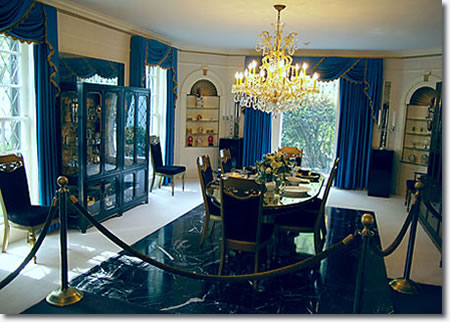
The Graceland Dining Room.
There is a bedroom behind the living room, and the kitchen is located behind the dining room. The original one-story wing on the north end of the residence includes a mechanical room, bedroom, and bath.
The Jungle Room
In the mid-1960s, Elvis Presley constructed a substantial addition (14 by 40 feet) on the rear (east) facade of the house to serve as a den. It became known as the Jungle Room because of its furnishings, as well as the built-in waterfall of cut fieldstone on its north wall. The one-story section at the house's north end was constructed as a four-car garage. It was remodeled as an apartment in the mid-1960s, later used as offices, and currently provides additional exhibit space for the house museum.
Elvis used this room to record sixteen songs, on February 2-8 and October 29-30, 1976 - that were made into two albums, From Elvis Presley Boulevard and Moody Blue and produced the hit singles, Moody Blue and Way Down. One of the best CDs you could ever own is the Sony BMG, Follow That Dream Collectors Label release, The Jungle Room Sessions containing outtakes from the sessions.
TV and Pool Rooms
Elvis remodeled two of the rooms in the basement in 1974, the TV room in the southwest corner, and the pool room in the northwest corner. The TV room's west wall is painted with a lightning bolt and cloud motif in reference to the personal logo Elvis adopted in the 1970s, the initials TCB, and a lightning bolt, for 'taking care of business in a flash'. The south wall has three built-in television sets, a stereo, and cabinets for Elvis' record collection. The walls and ceiling of the pool room are covered with 350-400 yards of pleated cotton fabric.
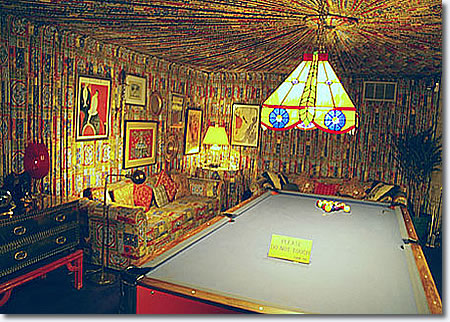
The Graceland Pool Room.
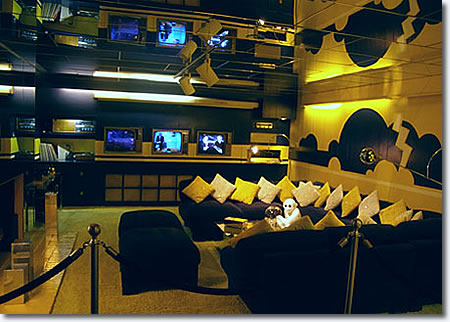
The Graceland TV Room.
The second floor : Upstairs at Graceland
Graceland's second floor is still maintained as a private residence and is not open to the public. The second floor includes Elvis' bedroom at the southwest corner; his dressing room and bath room at the northwest corner; his daughter, Lisa Marie's bedroom in the northeast corner; and a bedroom in the southeast corner that was Elvis' private personal office.
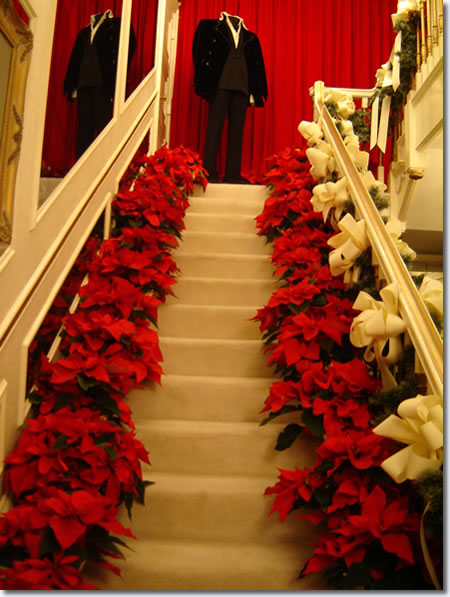
The stairs to Elvis' private private residence. Photo by Ester, an Elvis fan from Argentina.
Building on ...
In the mid-1960s, Elvis constructed a large building, or wing, on the south side of the main house, between the music room in the original one-story wing and the swimming pool area. The kidney-shaped swimming pool and cut-stone patio, constructed in 1957, are adjacent to the south side of the Trophy Building. Before the site opened to the public, there was a small bath house just north of the pool, at the southeast corner of the Trophy Building. The bath house was remodeled to provide public restrooms with handicapped access.
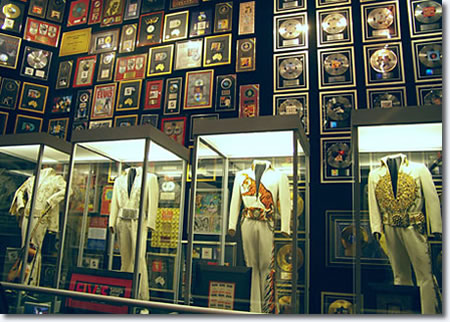
The Graceland Trophy Room.
A small 'breezeway' (which is enclosed, not open to the elements) was constructed to connect the main house to the new wing on the south side of the music room.
The new wing initially housed a slot car track but was later remodeled to house Elvis' many awards, trophies, and other honors, as well as memorabilia, guitars, jewelery, and stage costumes. Today it is known as the Trophy Building and a new entrance with plate-glass double doors was constructed at the northeast corner of the wing to provide better access for visitors.
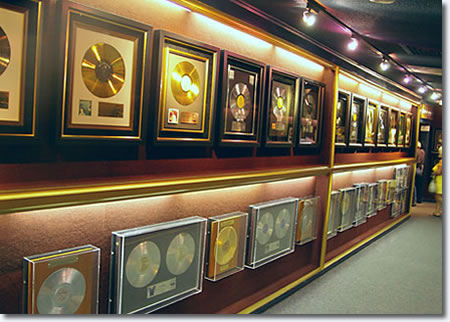
Elvis Presley's Gold Records on display at Graceland.
The Trophy Building includes the Hall of Gold, an 80-foot-long room that showcases Elvis' original gold and platinum albums and singles in cases that line both sides of the Hall. There are also a number of display cases that exhibit Elvis Presley's many other awards, plaques, and proclamations, including his three Grammy Awards and Lifetime Achievement Award from the National Academy for the Recording Arts and Sciences.
The Grammy Awards

Elvis Presley's three Grammy Awards on display at Graceland.
Vernon's Office
A small, one-story wood-framed building, constructed in 1939, probably housed servants originally. Elvis' father Vernon served as his business manager, and this building became his office after Elvis bought Graceland.
Guns!, Guns!, Guns!
There is no secret that Elvis loved fire arms, and liked to practice. The smokehouse (1939) is a one-story, two-room brick structure with two heavy wooden doors on its front facade. Elvis used it for target practice and storage.
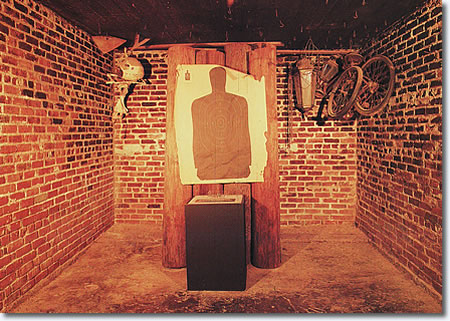
The smokehouse (1939) is a two-room brick structure with two heavy wooden
doors on its front facade. Elvis used it for target practice and storage.
The Barn
There are three trailers at the back of the property in the northeast corner. The two double-wide's and one regular sized trailer (late 1960s, 1974) provided housing for friends and employees, and are currently used by Graceland employees.
The barn (1939) is located near the rear property line in the southeast corner. It is a wood-sided structure with gambrel roof, and still serves as a stable for the horses at Graceland, which has several pastures bordered by white wooden fences in front of and behind the residence.
![]() Elvis Presley : Rising Sun and other Horses at Graceland
Elvis Presley : Rising Sun and other Horses at Graceland
The Racquetball Building (1975)
In 1975, Elvis built a 2,100 square foot, two-story structure at Graceland to accommodate his new interest for the sport of racquetball. The racquetball building is a large, two-story rectangular building (2,200 square feet). The interior included a lounge area and racquetball court on the first floor and upstairs, Elvis' private dressing room, Jacuzzi spa, and facilities for guests.
Today, the racquetball court serves as an additional exhibit area for Elvis' many awards, as well as his stage costumes. The court's entire north and east walls are covered in gold and platinum records presented to the Elvis Presley Estate in August 1992 by RCA executives and the Recording Industry Association of America (RIAA), the largest single presentation of gold and platinum awards ever made.
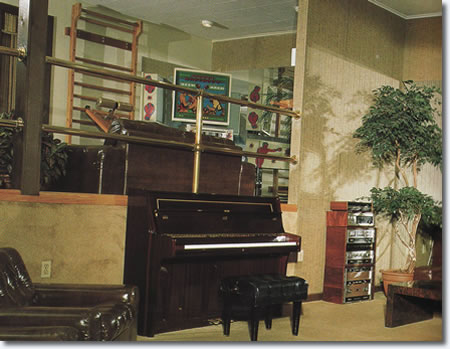
Inside the Racquetball Building.
August 16, 1977
Elvis was in this building just hours before his death on Tuesday, August 16, 1977. He had been out for a late-night dental appointment and came home shortly offer midnight. Elvis, his girlfriend Ginger Alden, along with his cousin Billy Smith and wife Jo played a few light-hearted games, then relaxed in this lounge around the piano. Elvis sat at this upright piano on that last day and played and sang.
Two of the tunes were 'Unchained Melody' and 'Blue Eyes Crying In The Rain'. Shortly thereafter, Elvis retired to his private suite upstairs at the mansion around 7:00am to rest for his evening departure to Portland, Maine; the beginning of the next leg of his concert tour schedule. At midday, he was found collapsed upstairs at Graceland and was taken by ambulance to Baptist Memorial Hospital. Elvis was pronounced dead on arrival due to heart failure. In a matter of moments, the shock registered around the world.
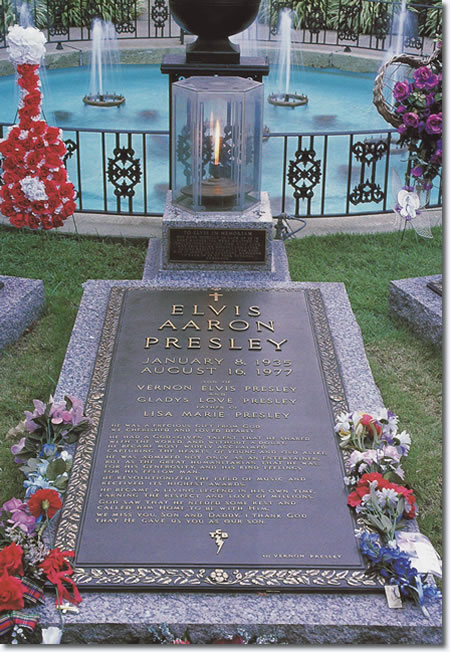
After Elvis' death on August 16, 1977, security issues at Forest Hill Cemetery, his original burial site, led to his reburial on October 2, 1977 on the south side of the pool with fountains. An eternal flame encased in a hexagonal glass container sits at the head of Elvis' grave.
Elvis' two airplanes, The Lisa Marie Convair 880 and JetStar were returned to Graceland in 1984 and are on display opposite Graceland. See our Elvis Presley Biography section for more on Elvis Presley.
Getting to Graceland: A little less conversation, a little more action
Graceland was wonderful. Though you sometimes might hear people say that it's not as big as they had expected, I didn't feel that way at all. It's a mighty big house, and yet it still has the feel of a home. There are moments on the Graceland tour that are simply fun, such as the rooms dedicated to Elvis' gold records and jumpsuits, yet there are also moments that are sad and poignant, such as when you find yourself standing before the very same piano that Presley played on August 16, 1977 - just hours before his death. You see a swing-set in the backyard, where his daughter once played, and a pool where good times were had by family and friends. And yet just 20 yards away, you also visit his grave. Read the article. By Alan K. Stout / 2013.
![]() Article by David Troedson and Davis Adams. Most photos by Scott Jenkins.
Article by David Troedson and Davis Adams. Most photos by Scott Jenkins.
Graceland Links
![]() Elvis Presley's Graceland
Elvis Presley's Graceland
![]() Elvis Presley's private Graceland upstairs rooms
Elvis Presley's private Graceland upstairs rooms
![]() Elvis Presley's Home Sweet Homes
Elvis Presley's Home Sweet Homes
![]() Elvis Presley's Graceland : The Tour
Elvis Presley's Graceland : The Tour
![]() The Graceland Wall : To Elvis With Love
The Graceland Wall : To Elvis With Love
![]() The 'Den' : The Jungle Room
The 'Den' : The Jungle Room
![]() Elvis Presley : Home Movies of Graceland
Elvis Presley : Home Movies of Graceland
![]() Drone Footage of Graceland
Drone Footage of Graceland
![]() The Graceland Music Gates
The Graceland Music Gates
![]() 3764 Elvis Presley Boulevard, Memphis Tennessee
3764 Elvis Presley Boulevard, Memphis Tennessee
![]() Visiting Elvis Presley's Graceland
Visiting Elvis Presley's Graceland
![]() Elvis Presley : Rising Sun and other Horses at Graceland
Elvis Presley : Rising Sun and other Horses at Graceland
![]() Rare Film of Elvis in his car signing autographs at the entrance to Graceland
Rare Film of Elvis in his car signing autographs at the entrance to Graceland
History
![]() Graceland, Before Elvis
Graceland, Before Elvis
![]() The Moores & The Presleys at Graceland
The Moores & The Presleys at Graceland
Over the years
![]() Graceland Newspaper article : March 1957
Graceland Newspaper article : March 1957
![]() Elvis Presley with the music gates of Graceland : April 22, 1957
Elvis Presley with the music gates of Graceland : April 22, 1957
![]() Photos of Graceland : April, 1962
Photos of Graceland : April, 1962
![]() Elvis Presley at Graceland : March 1965
Elvis Presley at Graceland : March 1965
![]() Elvis Presley : Graceland : February 16, 1968
Elvis Presley : Graceland : February 16, 1968
![]() Jerry Lee Lewis, Arrested at the Gates of Graceland
Jerry Lee Lewis, Arrested at the Gates of Graceland
![]() The Night Springsteen Jumped the Fence at Graceland
The Night Springsteen Jumped the Fence at Graceland
![]() Elvis Presley's 1955 Pink Cadillac at Graceland
Elvis Presley's 1955 Pink Cadillac at Graceland
![]() President Bush and Japanese Prime Minister Koizumi Visit Graceland
President Bush and Japanese Prime Minister Koizumi Visit Graceland
![]() Graceland Mansion Designated National Historic Landmark
Graceland Mansion Designated National Historic Landmark
Elvis Presley Biography
![]() Elvis Presley Family History : 1669-1935
Elvis Presley Family History : 1669-1935
![]() Elvis Presley Biography
Elvis Presley Biography
![]() Gladys and Vernon Presley - Elvis Presley's Mother and Father
Gladys and Vernon Presley - Elvis Presley's Mother and Father
![]() Jessie D. McDowell (J.D.) Presley - Elvis Presleys Grandfather
Jessie D. McDowell (J.D.) Presley - Elvis Presleys Grandfather
![]() For a more (very) detailed history of Elvis Presley see Elvis Presley 1935-1953
For a more (very) detailed history of Elvis Presley see Elvis Presley 1935-1953
I've stood aloft on this stately hill
for lo, these many years.
I've known the great joys of life
and wept its saddest tears.
I've seen the leaves turn umber
then bow to winter's snow.
I've basked in the lights of Christmas
and my pride would always show.
I've shared the kiss of a mother's love
and the paternal pride of a dad.
I've known the joy of bride and child;
thank God for the memories I've had.
My owner redefined musical history
with his unique style and voice.
I saw accolades heaped upon him;
he was clearly our nation's choice.
I've seen his fans come up the hill
and stand at windswept graves.
I, too would cry along with them;
I'd tire of being brave.
Today my columns seem more erect;
my pride shows within these walls.
My life has taken on new meaning;
his friends have come to call.
I knew that one day you would come;
I've waited and counted the minutes.
Even though my owner is away just now,
his heart is still here within it!
1982, Janelle McComb.
 Tupelo's Own Elvis Presley DVD
Tupelo's Own Elvis Presley DVD
Never before have we seen an Elvis Presley concert from the 1950's with sound. Until Now! The DVD Contains recently discovered unreleased film of Elvis performing 6 songs, including Heartbreak Hotel and Don't Be Cruel, live in Tupelo Mississippi 1956. Included we see a live performance of the elusive Long Tall Sally seen here for the first time ever. + Plus Bonus DVD Audio.
This is an excellent release no fan should be without it.
The 'parade' footage is good to see as it puts you in the right context with color and b&w footage. The interviews of Elvis' Parents are well worth hearing too. The afternoon show footage is wonderful and electrifying : Here is Elvis in his prime rocking and rolling in front of 11.000 people. Highly recommended.
Tupelo's Own Elvis Presley DVD Video with Sound.




